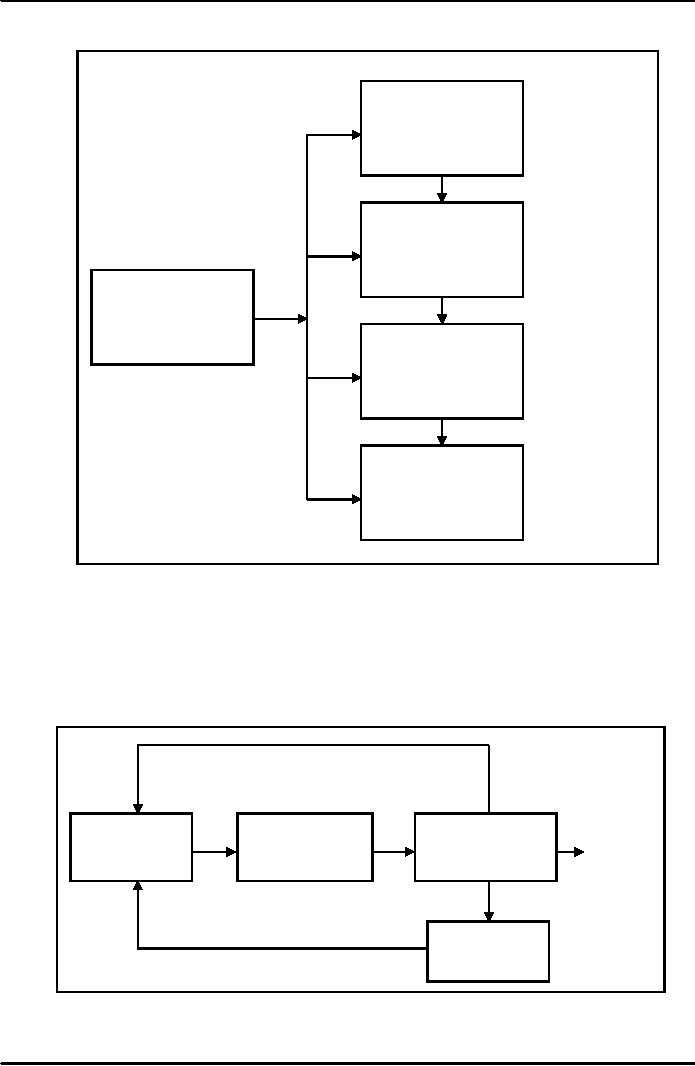 |
PLANNING – I:Four Major Aspects of Planning, Types of Plans |
| << DELEGATION OF AUTHORITY:The Art of Delegation, Coordination |
| PLANNING – II:Planning ProcessThree principles of plans >> |

Introduction
To Public
AdministrationMGT111
VU
LESSON
18
PLANNING
I
At the
end of the lecture students
will be able to
understand:
-
The
importance & definition of Planning;
-
What
is managerial planning and
its importance;
-
Basic
principles underlying planning
and
-
Types
of plans
Importance
of Planning
Planning
is the most important activity of an
organization and of managers. Because
without
planning
organizations may not be
able to achieve their goals
and objective.
Definition
Planning
is the French word `prevoyance',
which means to look ahead.
According to Pfiffner
and
Presthus
planning is "a rational process
characterized of all human
behaviour."
According
to Dimock and Dimock
"Planning is an organized attempt to anticipate
and to make
rational
arrangement for dealing with
future problems by projecting
trends."
According
to Simon, Smithburg and Victor A.
Thomson: "Planning is that activity
that concern
itself
with proposal for future, evaluation of
alternative proposals and with method by
which these
proposals
may be achieved."
Planning
is also defined as future
course of action.
The
resources have to be managed to
achieve goals which exist in
future point in time.
In
all definition of planning,
there is one common element
i.e. "Future course of
action".
Levels
of Planning
Planning
is done at different level; therefore its
size and magnitude is
different. Following
are
different
levels of plan:
1.
National
level is made at the country
level.
2.
Provincial
level is made at the provincial
level.
3.
Organization
level is made at organization level.
4.
Department
level is made of department level.
5.
Unit
level is made at unit level.
6.
Personal
level plan could be professional plan or private
plan.
Four
Major Aspects of
Planning
The
nature of planning can be understood by
examining four aspects:
1.
Its
contribution to purpose and
objectives
2.
Its
importance in managerial task
3.
Its
pervasiveness
4.
The
efficiency Vs. effectiveness of
plans
1.
The
contribution of plan to purpose
and objectives: Every plan
must contribute to the
accomplishment
of purpose of the organization. This
concept derives from the
nature of the
organized
enterprise which exists for
the accomplishment of the group
purpose.
2.
The
importance of planning to the managerial
tasks: Planning precedes all
other managerial
tasks.
(organizing,
staffing leading, motivating,
controlling, budgeting and evaluating) It is unique as
it
involves
setting of objectives.
65

Introduction
To Public
AdministrationMGT111
VU
Plan
as Foundation of Management
Figure
1
What
kind of
organization
structure
to have
Which
helps us
to
know?
What
kind of people
we
need and when
Plans
Which
affect the
kind
of
Objectives
and how
leadership
to
achieve them
How
most effectively
to
lead
To
ensure
success
of plan
By
developing
standards
of control
Figure
1 shows that plans sets
out objectives, and then the
kind of organization structure will
be
determined
that will have achieve
those objectives. Then to
achieve the plan objectives the manager
should
select
right people. After
selection of right people then
these must be effectively
led. Finally the
control
standards
must be developed to determine if plan
has achieved the
objectives.
Relationship
of Planning and Controlling
Figure
2
Controlling:
Implementation
No
Planning
Comparing
plans
of
Plan
Deviation
with
result
Deviation
Corrective
action
66

Introduction
To Public
AdministrationMGT111
VU
Figure
2 shows the relationship between planning
and controlling. The relationship
between
planning
and controlling is inextricable, because
the two support each
other.
3.
The
Pervasiveness: Planning is a function of
all managers. If managers
are not allowed to plan to
a
certain
degree then they may not be
able to function as manager.
All managers plan- from
chief
executive
to the first level supervisor.
4.
The
efficiency vs. effectiveness of plans: A
plan is said to be efficient if it
achieves its purpose
with
minimizing
cost. It is the contribution of the plan to the
objectives. E.G. If cost is higher
than the
benefits,
the plan is said to be inefficient.
Effectiveness is the achievement of goals
and objectives set
out
in the plan.
Types
of Plans
Plans
are future course of action
and these are varied
according to the time frame. These
are
classified
as:
1.
Purpose
or Mission
2.
Objectives
or Goals
3.
Strategies
4.
Policies
5.
Procedures
6.
Rules
7.
Programmes
8.
Budgets
We
will examine each
separately.
1.
Purpose or Mission
The
mission or purpose identifies the basic
task of the organization. Every organization
should
have
a purpose or mission. Example: The
purpose of National Highway
Authority is to design, build
and
operate
national highways. The
purpose of courts is to interpret
laws. So each organization has
its purpose.
2.
Objectives or Goals
Objectives
or goals are ends towards
which activity is aimed.
These represent not only the
end
point
of planning but also end
toward which organizing, staffing,
leading and controlling are
aimed. While,
the
objectives are the basic plan of an
organization, its department may have
objectives. Which are
more
specific
and these are sometime
called "targets". Example: Objectives of
an organization is to make profits
by
producing television sets. The
objectives of the production department
would be to produce
2000
television
sets in a year of given design
and quality at a given
cost
3.
Strategies
Strategies
mean `grand plan' made in
the light of what an opponent might do or
not do. Strategy is
defined
as determination of long term plan of an
organization and following course of
action and allocation
of
resources necessary to achieve the
goals
4.
Policies
Policies
are general statements or understanding
that guide or channel
thinking in decision
making.
Not
all policies are "statements"; they
can be implied from the
actions of managers. Policies
define an area
within
which decision is to be made
and ensure that the decision
will be consistent with and
contribute to
objectives.
Example: Policy of Privatization
5.
Procedures
Procedures
are plans that establish a
required method of handling future
activities. They are
guides
to
action, rather than to thinking and they
spell out the exact manner
in which activities are to be
accomplished.
Example: Procedure of making of passport,
how police should challan a traffic
violator
6.
Rules
Rules
spell out specific action or
non action, allowing no discretion. Rules
are unlike procedures
in
that
they guide action without specifying time
sequence. In fact a procedure is
part of rule; a rule may
or
may
not be part of procedure. Example:
Traffic Rules, Pension
Rules
67

Introduction
To Public
AdministrationMGT111
VU
Concepts:
Plan:
a
document which delineates future
course of action.
Pervasiveness
of Plan:
existence
of plan at all level of the organization.
Control:
establishing
standards and measuring
performance against
it.
68
Table of Contents:
- INTRODUCTION:Institutions of State, Individualism
- EVOLUTION OF PUBLIC ADMINISTRATION:Classical School, The Shovelling Experiment
- CLASSICAL SCHOOL OF THOUGHTS – I:Theory of Bureaucracy, Human Relation Approach
- CLASSICAL SCHOOL OF THOUGHTS – II:Contributors of This Approach
- HUMAN RELATIONS SCHOOLS:Behavioural School, System Schools
- POWER AND POLITICS:Conflict- as Positive and Negative, Reactions of Managers, Three Dimensional Typology
- HISTORY OF PUBLIC ADMINISTRATION – I:Moghul Period, British Period
- HISTORY OF PUBLIC ADMINISTRATION – II
- CIVIL SERVICE:What are the Functions Performed by the Government?
- CIVIL SERVICE REFORMS:Implementation of the Reforms, Categories of the Civil Service
- 1973 CONSTITUTION OF PAKISTAN:The Republic of Pakistan, Definition of the State
- STRUCTURE OF GOVERNMENT:Rules of Business, Conclusion
- PUBLIC AND PRIVATE ADMINISTRATION:The Public Interest, Ambiguity, Less Efficient
- ORGANIZATION:Formal Organizations, Departmentalization
- DEPARTMENTALIZATION:Departmentalization by Enterprise Function, Departments by Product
- POWER AND AUTHORITY:Nature of Relationship, Delegation of Functional Authority
- DELEGATION OF AUTHORITY:The Art of Delegation, Coordination
- PLANNING – I:Four Major Aspects of Planning, Types of Plans
- PLANNING – II:Planning ProcessThree principles of plans
- PLANNING COMMISSION AND PLANNING DEVELOPMENT:Functions, Approval Authority
- DECISION MAKING:Theories on Decision Making, Steps in Rational Decision Making
- HUMAN RESOURCE MANAGEMENT (HRM):Importance of Human Resource, Recruitment
- SELECTION PROCESS AND TRAINING:Levels at Which Selection takes Place, Training and Development
- PERFORMANCE APPRAISAL:Formal Appraisals, Informal Appraisals
- SELECTION AND TRAINING AND PUBLIC ORGANIZATIONS:Performance Evaluation,
- PUBLIC FINANCE:Background, Components of Public Finance, Dissimilarities
- BUDGET:Components of Public Income, Use of Taxes, Types of Taxation
- PUBLIC BUDGET:Incremental Budget, Annual Budget Statement, Budget Preparation
- NATIONAL FINANCE COMMISSION:Fiscal Federalism Defined, Multiple Criteria
- ADMINISTRATIVE CONTROL:Types of Accountability, Internal Control, External Control
- AUDIT:Economy, Effectiveness, Objectives of Performance Audit, Concepts
- MOTIVATION:Assumptions about Motivation, Early ViewsThree Needs
- MOTIVATION AND LEADERSHIP:Reinforcement Theory, Leadership, The Trait Approach
- LEADERSHIP:Contingency Approaches, Personal Characteristics of Employees
- TEAM – I:Formal & Informal teams, Functions of Informal Groups, Characteristics of Teams
- TEAM – II:Team Cohesiveness, Four ways to Cohesiveness, Communication
- COMMUNICATION – I:Types of Communication, How to Improve Communication
- COMMUNICATION – II:Factors in Organizational Communication, Negotiating To Manage Conflicts
- DISTRICT ADMINISTRATION:The British Period, After Independence, The Issues
- DEVOLUTION PLAN – I:Country Information, Tiers or Level of Government
- DEVOLUTION PLAN – II:Aim of Devolution Plan, Administrative Reforms, Separation of powers
- POLITICAL REFORMS:District, Tehsil, Functions of Union Council, Fiscal Reforms
- NEW PUBLIC MANAGEMENT (NPM):Strategy, Beginning of Management Approach
- MANAGERIAL PROGRAMME AGENDA – I
- MANAGERIAL PROGRAMME AGENDA – II:Theoretical Bases of Management, Critique on Management